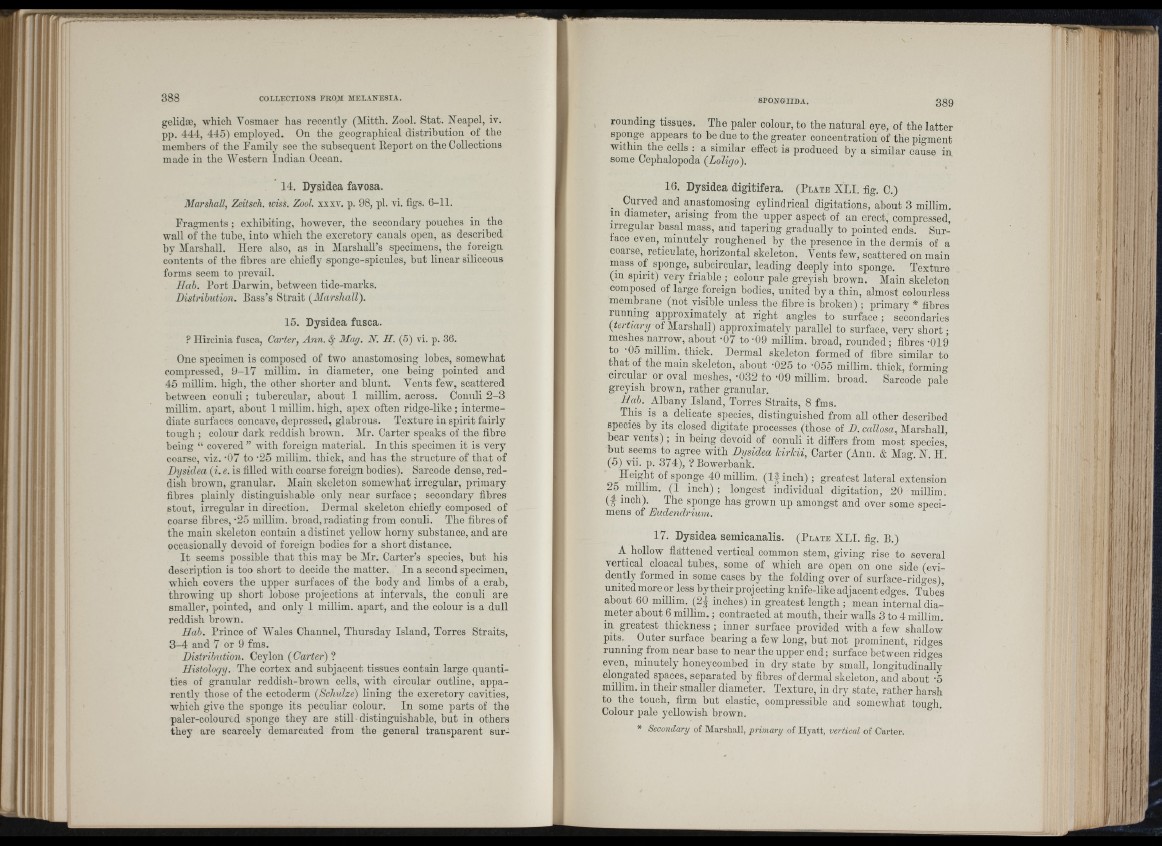
Y — —
li M'Ai5 r i'
■k I'
i If
388 COLLECTIONS FROM MELANESIA. SPONGIIDA. 389
U
î .
î '
t i
i, i r
i!
iil
f
gelidae, which Vosmaer has recently (Mitth. Zool. Stat. Neapel, iv.
pp. 444, 445) employed. On the geographical distribution of the
members of the Family see the subsequent Report on the Collections
made iu the Western Indian Ocean.
14. Dysidea favosa.
Marshall, Zeitsch. wiss. Zool. xxxv. p. 98, pi. vi. figs. 6-11.
Fragments ; exhibiting, however, tho secondary pouches in the
wall of the tube, into which the excretory canals open, as described
by Marshall. Here also, as in Marshall’s specimens, the foreign
contents of the fibres are chiefly sponge-spicules, but linear siliceous
forms seem to prevail.
Hah. Port Darwin, between tide-marks.
Distribution. Bass’s Strait (Marshall).
15. Dysidea fusca.
? Hircinia fusca, Carter, Ann. ^ Alag. N. H. (5) vi. p. 36.
One specimen is composed of two anastomosing lobes, somewhat
compressed, 9-17 millim. in diameter, one being pointed and
45 millim. high, the other shorter and blunt. Vents few, scattered
between connli; tubercular, about 1 millim. across. Conuli 2 -3
millim. apart, about I millim.high, apex often ridge-like; intermediate
surfaces concave, depressed, glabrous. Texture in spirit fairly
tough ; colour dark reddish brown. Mr. Carter speaks of the fibre
being “ covered ” with foreign material. In this specimen it is very
coarse, viz. -07 to -25 millim. thick, and has the structure of th at of
Dysidea (i. e. is filled with coarse foreign bodies). Sarcode dense, reddish
brown, granular. Main skeleton somewhat irregular, primary
fibres plainly distinguishable only near surface; secondary fibres
stout, irregular in direction. Dermal skeleton chiefly composed of
coarse fibres, -25 millim. broad, radiating from conuli. The fibres of
the main skeleton contain a distinct yellow horny substance, and are
occasionally devoid of foreign bodies for a short distance.
I t seems possible th at this may he Mr. Carter’s species, but his
description is too short to decide the matter. In a second specimen,
which covers the upper surfaces of the body and limbs of a crab,
throwing up short lohose projections at intervals, the conuli are
smaller, pointed, and only 1 millim. apart, and the colour is a dull
reddish brown.
Hab. Prince of Wales Channel, Thursday Island, Torres Straits,
3 -4 and 7 or 9 fms.
Distribution. Ceylon (Carter)"!
Histology. The cortex and subjacent tissues contain large quantities
of granular reddish-brown cells, with circular outline, apparently
those of the ectoderm (Schulze) lining the excretory cavities,
which give the sponge its peculiar colour. In some parts of the
paler-colourtd sponge they are still distinguishable, hut in others
they are scarcely demarcated from the general transparent surroundmg
tissues. The paler colour, to the natural eye, of the latter
sponge appears to be due to the greater concentration of the pigment
within the cells : a similar effect is produced by a similar cause in
some Cephalopoda (Loligo).
16. Dysidea digitifera. (P la te XLI. fig. C.)
_ Curved and anastomosing cylindrical digitations, about 3 millim.
in diameter, arising from the upper aspect of an erect, compressed,
iiiegular basal mass, and tapering gradually to pointed ends. Surface
even, minutely roughened by the presence in the dermis of a
coarse, reticulate, horizontal skeleton. Vents few, scattered on main
mass of sponge, subcircular, leading deeply into sponge. Texture
(in spirit) very friable ; colour pale greyish brown. Main skeleton
composed of large foreign bodies, united by a thin, almost colourless
membrane (not visible unless tho fibre is broken) ; primary * fibres
running approximately at right angles to surface; secondaries
(tertiary of Marshall) approximately parallel to surface, very short •
meshes narrow, about -07 to -09 millim. broad, rounded ; fibres -019
to -05 millim. thick. Dermal skeleton formed of fibre similar to
th at of the main skeleton, about -025 to -055 millim. thick, forming
circular or oval meshes, -032 to -09 millim. broad. Sarcode pale
greyish brown, rather granular.
Hab. Albany Island, Torres Straits, 8 fms.
This is a delicate species, distinguished from aU other described
species by its closed digitate processes (those of D. callosa, Marshall,
bear vents) ; in being devoid of conuli it differs from most species,
but seems to agree with Dysidea Idrlcii, Carter (Ann. & Mag. N. H.
(5) vii. p. 374), ? Bowerbank.
Height of sponge 40 millim, (I|-in ch ) ; greatest lateral extension
2o millim. ( I in ch ); longest individual digitation, 20 millim.
(5 inch). The sponge has grown up amongst and over some specimens
of Eudendriuin.
17. Dysidea semicanalis. (P la te XLI. fig. B.)
A hollow flattened vertical common stem, giving rise to several
vertical cloacal tubes, some of which are open on one side (evidently
formed in some cases by the folding over of surface-ridges),
united more or less by their projecting knife-like adjacent edges. Tubes
about 60 millim. (2^ inches) in greatest length ; mean internal diameter
about 6 millim. ; contracted at mouth, their walls 3 to 4 millim.
in greatest thickness ; inner surface provided with a few shallow
pits, ^ Outer surface bearing a few long, but not prominent, ridges
running from near base to near the upper end ; surface between ridges
even, minutely honeycombed in dry state by small, longitudinally
elongated spaces, separated by fibres of dermal skeleton, and about -5
millim. in their smaller diameter. Texture, iu dry state, rather harsh
to the touch, firm but elastic, compressible and somewhat tough.
Colour pale yellowish brown.
* Secondary of Marshall, primary of Hyatt, vertical of Carter.
!.(